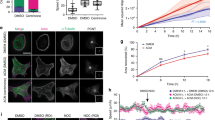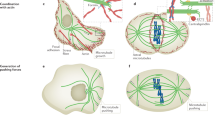Abstract
The well recognized activities of the mammalian centrosome — microtubule nucleation, duplication, and organization of the primary cilium — are under the control of the cell cycle. However, the centrosome is more than just a follower of the cell cycle; it can also be essential for the cell to transit G1 and enter S phase. How the centrosome influences G1 progression is a mystery.
This is a preview of subscription content, access via your institution
Access options
Subscribe to this journal
Receive 12 print issues and online access
$189.00 per year
only $15.75 per issue
Buy this article
- Purchase on Springer Link
- Instant access to full article PDF
Prices may be subject to local taxes which are calculated during checkout


Similar content being viewed by others
References
Karsenti, E. & Vernos, I. The mitotic spindle: a self-made machine. Science 294, 543–547 (2001).
Wadsworth, P. & Khodjakov, A. E pluribus unum: towards a universal mechanism for spindle assembly. Trends Cell Biol. 14, 413–419 (2004).
Hinchcliffe, E. H., Miller, F. J., Cham, M., Khodjakov, A. & Sluder, G. Requirement of a centrosomal activity for cell cycle progression through G1 into S phase. Science 291, 1547–1550 (2001).
Khodjakov, A. & Rieder, C. L. Centrosomes enhance the fidelity of cytokinesis in vertebrates and are required for cell cycle progression. J. Cell Biol. 153, 237–242 (2001).
Piel, M., Nordberg, J., Euteneuer, U. & Bornens, M. Centrosome-dependent exit of cytokinesis in animal cells. Science 291, 1550–1553 (2001).
Rieder, C. L., Faruki, S. & Khodjakov, A. The centrosome in vertebrates: more than a microtubule-organizing center. Trends Cell Biol. 11, 413–419 (2001).
Murray, A. W. & Kirschner, M. W. Cyclin synthesis drives the early embryonic cell cycle. Nature 339, 275–280 (1989).
Sluder, G., Miller, F. J. & Rieder, C. L. Reproductive capacity of sea urchin centrosomes without centrioles. Cell Motil. Cytoskeleton 13, 264–273 (1989).
Snyder, J. A. & McIntosh, J. R. Initiation and growth of microtubules from mitotic centers in lysed mammalian cells. J. Cell Biol. 67, 744–760 (1975).
Kuriyama, R. & Borisy, G. G. Microtubule-nucleating activity of centrosomes in Chinese hamster ovary cells is independent of the centriole cycle but coupled to the mitotic cycle. J. Cell Biol. 91, 822–826 (1981).
Vandre, D. D. & Borisy, G. G. in Mitosis: Molecules and Mechanisms (eds Hyams, J. S. & Brinkley, B. R.) 39–76 (Academic Press, New York, 1989).
Centonze, V. E. & Borisy, G. G. Nucleation of microtubules from mitotic centrosomes is modulated by a phosphorylated epitope. J. Cell Sci. 95, 405–411 (1990).
Vandre, D. D., Feng, Y. & Ding, M. Cell cycle-dependent phosphorylation of centrosomes: localization of phosphopeptide specific antibodies to the centrosome. Microsc. Res. Tech. 49, 458–466 (2000).
Khodjakov, A. & Rieder, C. L. The sudden recruitment of γ-tubulin to the centrosome at the onset of mitosis and its dynamic exchange throughout the cell cycle, do not require microtubules. J. Cell Biol. 146, 585–596 (1999).
Young, A., Dictenberg, J. B., Purohit, A., Tuft, R. & Doxsey, S. J. Cytoplasmic dynein-mediated assembly of pericentrin and γ-tubulin onto centrosomes. Mol. Biol. Cell 11, 2047–2056 (2000).
Sluder, G. in Centrosomes in Development and Disease (ed. Nigg, E.) 167–189 (Wiley-VCH, Weinheim, 2004).
Maniotis, A. & Schliwa, M. Microsurgical removal of centrosomes blocks cell reproduction and centriole generation in BSC-1 cells. Cell 67, 495–504 (1991).
Vogel, C., Kienitz, A., Hofmann, I., Muller, R. & Bastians, H. Crosstalk of the mitotic spindle assembly checkpoint with p53 to prevent polyploidy. Oncogene 23, 6845–6853 (2004).
Margolis, R. L., Lohez, O. D. & Andreassen, P. R. G1 tetraploidy checkpoint and the suppression of tumorigenesis. J. Cell. Biochem. 88, 673–683 (2003).
Uetake, Y. & Sluder, G. Cell cycle progression after cleavage failure: mammalian somatic cells do not possess a 'tetraploidy checkpoint'. J. Cell Biol. 165, 609–615 (2004).
Dammermann, A. & Merdes, A. Assembly of centrosomal proteins and microtubule organization depends on PCM-1. J. Cell Biol. 159, 255–266 (2002).
Balczon, R., Simerly, C., Takahashi, D. & Schatten, G. Arrest of cell cycle progression during first interphase in murine zygotes microinjected with anti-PCM-1 antibodies. Cell Motil. Cytoskeleton 52, 183–192 (2002).
Gromley, A. et al. A novel human protein of the maternal centriole is required for the final stages of cytokinesis and entry into S phase. J. Cell Biol. 161, 535–545 (2003).
Keryer, G. et al. Dissociation the centrosomal matrix protein AKAP450 from centrioles impairs centriole duplication and cell cycle progression. Mol. Biol. Cell 14, 2436–2446 (2003).
Augustin, A. et al. PARP-3 localizes preferentially to the daughter centriole and interferes with the G1/S cell cycle progression. J. Cell Sci. 116, 1551–1562 (2003).
Patzke, S. et al. Identification of a novel centrosome/microtubule-associated coiled-coil protein involved in cell-cycle progression and spindle organization. Oncogene 24, 1159–1173 (2005).
Quintyne, N. J. & Schroer, T. A. Distinct cell cycle-dependent roles for dynactin and dynein at centrosomes. J. Cell Biol. 159, 245–254 (2002).
Doxsey, S., Zimmerman, W. & Mikule, K. Centrosome control of the cell cycle. Trends Cell Biol. 15, 303–311 (2005).
Matsumoto, Y. & Maller, J. L. A centrosomal localization signal in cyclin E required for Cdk2-independent S phase entry. Science 306, 885–888 (2004).
Geng, Y. et al. Cyclin E ablation in the mouse. Cell. 114, 431–443 (2003).
Palazzo, R. E., Vogel, J. M., Schnackenberg, B. J., Hull, D. R. & Wu, L. in Curr. Top. Dev. Biol. (eds Palazzo, R. E. & Schatten, G.) 449–470 (Academic Press, San Diego, 2000).
Doxsey, S. J. Centrosomes as command centres for cellular control. Nature Cell Biol. 3, 105–108 (2001).
Fry, A. & Hames, R. in Centrosomes in Development and Disease (ed. Nigg, E.) 143–166 (Wiley-VCH, Weinheim, 2004).
La Terra, S. et al. The de novo centriole assembly pathway in HeLa cells: cell cycle progression and centriole assembly/maturation. J. Cell Biol. 168, 713–722 (2005).
Lanni, J. S. & Jacks, T. Characterization of the p53-dependent postmitotic checkpoint following spindle disruption. Mol. Cell. Biol. 18, 1055–1064 (1998).
Casenghi, M. et al. p53-independent apoptosis and p53-dependent block of DNA rereplication following mitotic spindle inhibition in human cells. Exp. Cell Res. 250, 339–350 (1999).
Ciciarello, M. et al. p53 displacement from centrosomes and p53-mediated G1 arrest following transient inhibition of the mitotic spindle. J. Biol. Chem. 276, 19205–19213 (2001).
Tritarelli, A. et al. p53 localization at centrosomes during mitosis and postmitotic checkpoint are ATM-dependent and require serine 15 phosphorylation. Mol. Biol. Cell 15, 3751–3757 (2004).
Kaverina, I., Krylyshkina, O. & Small, J. V. Microtubule targeting of substrate contacts promotes their relaxation and dissociation. J. Cell Biol. 146, 1033–1044 (1999).
Kaverina, I., Rottner, K. & Small, J. V. Targeting, capture, and stabilization of microtubules at early focal adhesions. J. Cell Biol. 142, 181–190 (1998).
Krylyshkina, O. et al. Nanometer targeting of microtubules to focal adhesions. J. Cell Biol. 161, 853–859 (2003).
D'Addario, M., Arora, P. D., Ellen, R. P. & McCulloch, C. A. Regulation of tension-induced mechanotranscriptional signals by the microtubule network in fibroblasts. J. Biol. Chem. 278, 53090–53097 (2003).
Trielli, M. O., Andreassen, P. R., Lacroix, F. B. & Margolis, R. L. Differential taxol-dependent arrest of transformed and nontransformed cells in the G1 phase of the cell cycle, and specific-related mortality of transformed cells. J. Cell Biol. 135, 689–700 (1996).
Sablina, A. A., Chumakov, P. M., Levine, A. J. & Kopnin, B. P. p53 activation in response to microtubule disruption is mediated by integrin–Erk signaling. Oncogene 20, 899–909 (2001).
Huang, S., Chen, C. S. & Ingber, D. E. Control of cyclin D1, p27Kip1, and cell cycle progression in human capillary endothelial cells by cell shape and cytoskeletal tension. Mol. Biol. Cell 9, 3179–3193 (1998).
Ingber, D. E. Tensegrity II: how structural networks influence cellular information processing networks. J. Cell Sci. 116, 1397–1408 (2003).
Wheatley, D. N. The Centriole: A Central Enigma of Cell Biology (Elsevier Biomedical Press, Amsterdam, 1982).
Paintrand, M., Moudjou, M., Delacroix, H. & Bornens, M. Centrosome organization and centriole architecture: their sensitivity to divalent cations. J. Struct. Biol. 108, 107–128 (1992).
Rieder, C. L. & Borisy, G. G. The centrosome cycle in PtK2 cells: Asymmetric distribution and structural changes in the pericentriolar material. Biol. Cell. 44, 117–132 (1982).
Sluder, G. & Rieder, C. L. Centriole number and the reproductive capacity of spindle poles. J. Cell Biol. 100, 887–896 (1985).
Vorobjev, I. A. & Nadezhdina, E. S. The centrosome and its role in the organization of microtubules. Int. Rev. Cytol. 106, 227–293 (1987).
Bornens, M., Paintrand, M., Berges, J., Marty, M. C. & Karsenti, E. Structural and chemical characterization of isolated centrosomes. Cell Motil. Cytoskeleton 8, 238–249 (1987).
Mogensen, M. in Centrosomes in Development and Disease (ed. Nigg, E.) 299–319 (Wiley-VCH, Weinheim, 2004).
Moritz, M., Rice, L. & Agard, D. in Centrosomes in Development and Disease (ed. Nigg, E.) 27–41 (Wiley-VCH, Weinheim, 2004).
Doxsey, S. Re-evaluating centrosome function. Nature Rev. Mol. Cell Biol. 2, 688–698 (2001).
Lange, B. M. Integration of the centrosome in cell cycle control, stress response and signal transduction pathways. Curr. Opin. Cell Biol. 14, 35–43 (2002).
Wilkinson, C., Andersen, J., Mann, M. & Nigg, E. in Centrosomes in Development and Disease (ed. Nigg, E.) 125–142 (Wiley-VCH, Weinheim, 2004).
Andersen, J. S. et al. Proteomic characterization of the human centrosome by protein correlation profiling. Nature 426, 570–574 (2003).
Preble, A. M., Giddings, T. M., Jr & Dutcher, S. K. Basal bodies and centrioles: their function and structure. Curr. Top. Dev. Biol. 49, 207–233 (2000).
Bornens, M. Centrosome composition and microtubule anchoring mechanisms. Curr. Opin. Cell Biol. 14, 25–34 (2002).
Piel, M., Meyer, P., Khodjakov, A., Rieder, C. L. & Bornens, M. The respective contributions of the mother and daughter centrioles to centrosome activity and behavior in vertebrate cells. J. Cell Biol. 149, 317–330 (2000).
Pelletier, L. et al. The Caenorhabditis elegans centrosomal protein SPD-2 is required for both pericentriolar material recruitment and centriole duplication. Curr. Biol. 14, 863–73 (2004).
Massague, J. G1 cell-cycle control and cancer. Nature 432, 298–306 (2004).
Kastan, M. B. & Bartek, J. Cell-cycle checkpoints and cancer. Nature 432, 316–323 (2004).
Ding, Q. et al. p27Kip1 and cyclin D1 are necessary for focal adhesion kinase (FAK) regulation of cell cycle progression in glioblastoma cells propagated in vitro and in vivo in the scid mouse brain. J. Biol. Chem. 280, 6802–6815 (2005).
Lowe, S. W., Cepero, E. & Evan, G. Intrinsic tumour suppression. Nature 432, 307–315 (2004).
Sherr, C. J. & McCormick, F. The RB and p53 pathways in cancer. Cancer Cell 2, 103–112 (2002).
Bode, A. M. & Dong, Z. Post-translational modification of p53 in tumorigenesis. Nature Rev. Cancer 4, 793–805 (2004).
Sherr, C. J. & Roberts, J. M. Living with or without cyclins and cyclin-dependent kinases. Genes Dev. 18, 2699–2711 (2004).
Sluder, G. Double or nothing. Curr. Biol. 2, 243–245 (1992).
Acknowledgements
I thank S. Doxsey, A. Khodjakov, A. Krzywicka, J. Nordberg and Y. Uetake for helpful discussions. C. English provided invaluable help in the preparation of the figures. I apologize to those whose work could not be cited owing to space limitations.
Author information
Authors and Affiliations
Ethics declarations
Competing interests
The author declares no competing financial interests.
Related links
Related links
DATABASES
Entrez Gene
Swiss-Prot
FURTHER INFORMATION
Rights and permissions
About this article
Cite this article
Sluder, G. Two-way traffic: centrosomes and the cell cycle. Nat Rev Mol Cell Biol 6, 743–748 (2005). https://doi.org/10.1038/nrm1712
Issue Date:
DOI: https://doi.org/10.1038/nrm1712
This article is cited by
-
Phasing in on the cell cycle
Cell Division (2018)
-
The interplay between centrosomes and the Hippo tumor suppressor pathway
Chromosome Research (2016)
-
LGALS3BP regulates centriole biogenesis and centrosome hypertrophy in cancer cells
Nature Communications (2013)
-
Centrosome-related genes, genetic variation, and risk of breast cancer
Breast Cancer Research and Treatment (2011)
-
Antizyme, a mediator of ubiquitin-independent proteasomal degradation and its inhibitor localize to centrosomes and modulate centriole amplification
Oncogene (2008)



